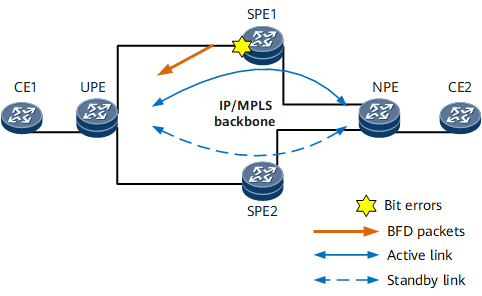Bit-Error-Triggered L3VPN Switching
Background
On an FRR-enabled HVPN, bit-error-triggered switching can be configured for VPN routes. With this function, if bit errors occur on the HVPN, VPN routes re-converge so that traffic switches to a bit-error-free link.
Principles
Trigger-LSP bit error detection must be enabled on each node's interfaces. In Figure 1, an HVPN is configured on an IP/MPLS backbone network. VPN FRR is configured on a UPE. If SPE1 detects bit errors, the processing is as follows:
SPE1 reduces the Local Preference attribute value or increase the Multi-Exit Discrimination (MED) attribute value. Then, the preference value of a VPN route that SPE1 advertises to an NPE is reduced. As a result, the NPE selects the VPN route to SPE2, not the VPN route to SPE1. Traffic switches to the standby link. In addition, SPE1 sends a BFD packet to notify the UPE of bit errors.
Upon receipt of the BFD packet, the UPE switches traffic to the standby link over the VPN route destined for SPE2.
If the bit errors on the active link are removed, the UPE re-selects the VPN routes destined for SPE1, and SPE1 restores the preference value of the VPN route to be advertised to the NPE. Then the NPE also re-selects the VPN route destined for SPE1.

- The hot standby function is not configured.
- Bit errors occur on both the primary and hot-standby CR-LSPs.
Usage Scenario
If L3VPN is used to carry user services and VPN FRR is deployed to ensure reliability, deploy bit-error-triggered L3VPN switching to minimize the impact of bit errors on user services and improve service quality.
